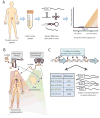The emergence of lncRNAs in cancer biology
- PMID: 22096659
- PMCID: PMC3215093
- DOI: 10.1158/2159-8290.CD-11-0209
The emergence of lncRNAs in cancer biology
Abstract
The discovery of numerous noncoding RNA (ncRNA) transcripts in species from yeast to mammals has dramatically altered our understanding of cell biology, especially the biology of diseases such as cancer. In humans, the identification of abundant long ncRNA (lncRNA) >200 bp has catalyzed their characterization as critical components of cancer biology. Recently, roles for lncRNAs as drivers of tumor suppressive and oncogenic functions have appeared in prevalent cancer types, such as breast and prostate cancer. In this review, we highlight the emerging impact of ncRNAs in cancer research, with a particular focus on the mechanisms and functions of lncRNAs.
Keywords: cancer; epigenetics; lncRNA; long noncoding RNA.
Conflict of interest statement
Figures




References
-
- Matsubara K, Okubo K. Identification of new genes by systematic analysis of cDNAs and database construction. Curr Opin Biotechnol. 1993;4:672–7. - PubMed
-
- Liang F, Holt I, Pertea G, Karamycheva S, Salzberg SL, Quackenbush J. Gene index analysis of the human genome estimates approximately 120,000 genes. Nat Genet. 2000;25:239–40. - PubMed
-
- Lander ES, Linton LM, Birren B, Nusbaum C, Zody MC, Baldwin J, et al. Initial sequencing and analysis of the human genome. Nature. 2001;409:860–921. - PubMed
-
- van Dijk EL, Chen CL, d’Aubenton-Carafa Y, Gourvennec S, Kwapisz M, Roche V, et al. XUTs are a class of Xrn1-sensitive antisense regulatory non-coding RNA in yeast. Nature. 2011;475:114–7. - PubMed
Publication types
MeSH terms
Substances
Grants and funding
LinkOut - more resources
Full Text Sources
Other Literature Sources

